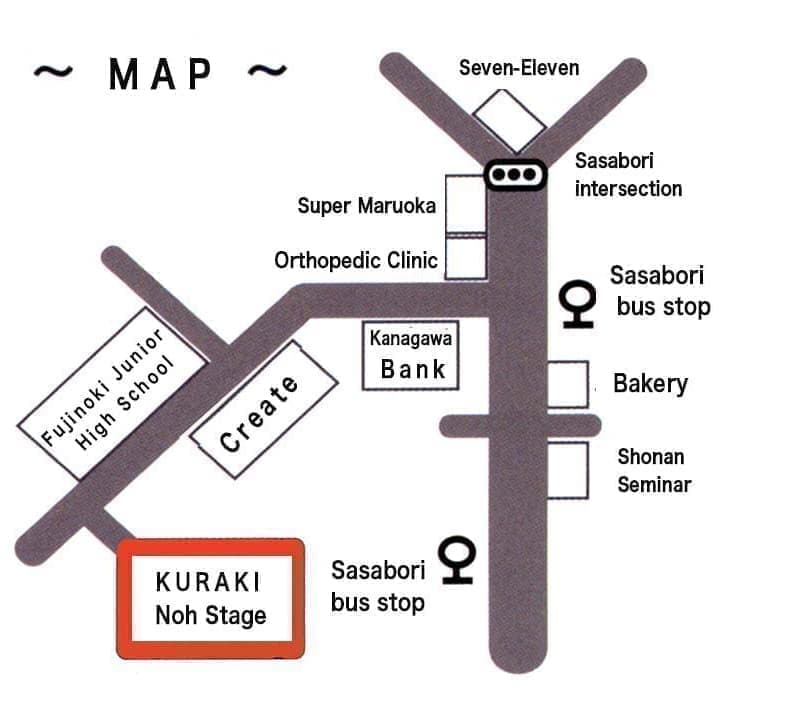History of the Kuraki Noh Stage (the Miyakoshi Memorial)
The Kuraki Noh Stage was founded by Nobuyoshi Ikenouchi, a senior director of the Nohgaku Performers’ Association, as a training institute for hayashi-kata, noh musical accompanists.
The stage was originally constructed in Hibiya area, Tokyo in 1917, and was designed by Seitaro Yamazaki who was an architect, professor at the Hosei University and noh expert known as Gakudo Yamazaki.
Years later, the stage belonged to Tokyo University of the Arts (TUA), formerly known as the Tokyo Conservatory, and students majoring in nohgaku trained hard at the stage.
A new stage was built at TUA in 1964. In the following year, Kenji Miyakoshi, a nohgaku enthusiast, took over the original stage. Then it was dismantled and reconstructed in the present location, former Kuraki-gun.
Miyakoshi contributed the stage to Yokohama city in 1984 so that the theatre where the stage exists is also known as the Miyakoshi Memorial.
The Kuraki Noh Stage has the artistic high-value kagami-ita, a backdrop wall on the stage, on which Hyakusui Hirafuku, a prominent figure in Japanese-style painting, drew a splendid picture of old pine trees.
Garden
The Miyakoshi Memorial with a Japanese style garden is located in the Kuraki Park which is approximately 26,450 square meters in size.
This place has a peaceful and elegant ambience and you can enjoy beautiful birdsongs and full of plants for all seasons.
The garden brings relaxation to visitors who savor not only the season’s transition but also unique facilities of Japanese style garden such as katoumado, a characteristic window shaped like a lotus flower, and suikinkutsu, a buried jar that makes sound when water drips into it.
Rooms
Distinctive painting of old pine trees
The stage has the artistic high-value kagami-ita, a backdrop wall on the stage, on which Hyakusui Hirafuku, a prominent figure in Japanese-style painting, drew a splendid picture of old pine trees.
The Kuraki Noh Stage with a long history and sense of dignity has produced many Living National Treasures since its foundation.
The stage is available for a noh recital, noh practice, any other concert and so on.
Size: stage (4.54 m×4.56 m), audience seats (52 tatamis = about 95 sqm), corridor (1.6 m×3.6 m), backstage area (8 tatamis = about 14.6 sqm)
The Internet is compatible with the latest standard Wi-Fi 6 (IEEE802.11ax)
Peaceful atmosphere
The room has a peaceful ambience in which you can hear the sound of suikinkutsu, and is available for a tea-ceremony or poetry meeting.
Size: tea-ceremony space (4.5 tatamis = about 8.2 sqm), preparation area (3 tatamis = about 5.5 sqm)
All-purpose room
The room is available for every kind of small-group lesson. It is allowed to eat and drink in this room.
In this photo, shoji screens are removed so as to see flowers and autumn leaves in the garden.
The room size is 14 tatamis (about 25.5 sqm). It can be divided into two (one is about 14.5 sqm and another is about 11 sqm).
Getting here U P
| Location | 8-21-7, Okamura, Isogo-ku, Yokohama-shi, Kanagawa-ken |
|---|---|
| Opening hours | 9:00am - 10:00pm We close the office at 5:00 pm if there are no events during evening hours |
| Business holiday | Closed during New Year’s holiday from 29th December to 3rd January And we will be temporarily and irregularly closed for equipment maintenance |
| Phone number | 045-761-3854 |
| Directions | About 5 minutes by foot from the Sasabori bus stop to the Kuraki Noh Stage |
| By Rail and Bus to the Sasabori bus stop | From the Kamiooka railway station on the Keikyu Line, take the Keihin Kyuko Bus (route no. 上7) or Yokohama city bus (route no. 64 or 78) for about 10 minutes to the Sasabori bus stop From the Isogo station on the JR Line, take the Yokohama city bus (route no. 64 or 78) for about 15 minutes to the Sasabori bus stop |
| From the Sasabori bus stop | Go along the road between the Sasabori Orthopedic Clinic and the Kanagawa Bank. You will find the sign of the Kuraki Noh Stage on the left after passing through the Fujinoki Junior High School. |
| By Taxi | About 5 minutes from the Taxi stand near the Kamiooka railway station (about 900 yen) |
| Car Park | The car park is available for free only for our users who made a parking reservation in advance. As the parking space can accommodate only up to 7 cars, we give preference to our visitors who use the facility in the theatre. So please note that “our users” in the above sentence does not include people who just visit for a stroll. The parking space in front of the gate can accommodate 3 vehicles. We also have another parking space in the garden for 4 vehicles. |






